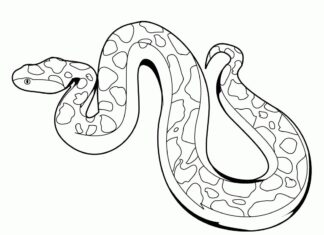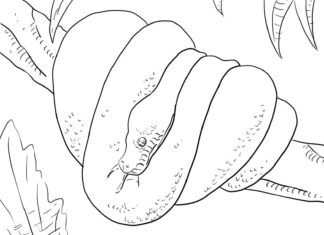Pythons are a family of large snakes that are known for their strength and ability to hunt large prey.
Python Coloring Pages
Information
- Classification: Pythons belong to the family Pythonidae in the order Squamata. They are non-venomous snakes.
- Geographical distribution: Pythons are found mainly in Africa, Asia and Australia. They prefer tropical and subtropical environments.
- Hunting method: Pythons are stranglers. They hunt by pressing their prey against themselves and strangling them, rather than using venom.
- Size: Pythons are among the largest snakes in the world. An example is the netted python, which can grow up to 7 meters or more in length.
- Reproduction: Pythons are oviparous. The female lays eggs and often wraps herself around them to protect and keep them warm.
- Diet: Pythons mainly hunt mammals and birds, although some species may also prey on reptiles. Young pythons often feed on smaller animals such as rodents.
- Thermal sensors: Pythons have special heat sensors along their jaws that help them detect the heat generated by potential prey, which is especially useful at night.
- Long digestion period: After consuming large prey, a python may not eat for weeks or even months. Its digestive tract is able to stretch considerably to accommodate large prey, and the digestion process can take a very long time.
- Dangers to humans: Although pythons are powerful and can pose a threat to humans, incidents of attacks on humans are relatively rare. However, in some areas where humans and pythons coexist in close proximity, such incidents can occur.
-
Security: Many species of pythons are endangered due to habitat loss and trade in exotic animals. Many countries have strict regulations on the trade in pythons and their products. trivia
- One of the longest snakes: The netted python is considered the longest snake in the world. Individuals of this species can reach up to 10 meters in length.
- No poison: Unlike venomous snakes, pythons are stranglers. Instead of paralyzing their prey with poison, pythons suffocate them by wrapping their powerful body around them.
- Thermal imaging: Pythons have the unique ability to "see" heat. Thanks to special sensing holes on their jaws, they can detect the heat given off by potential prey, giving them an advantage when hunting at night.
- Flexible jaw: Pythons can swallow prey much larger than their heads thanks to their extremely flexible ligaments and jawbones.
- Digestion of prey: After swallowing large prey, pythons spend days or even weeks digesting their meal. During this time, they are less active and often hide from predators.
- Motherhood: Some species of pythons are known for caring for their eggs. The female wraps herself around them, protecting them and keeping them warm until they hatch.
- Long posts: After eating large prey, a python may not eat for several months. Their metabolism is adapted to long periods of fasting.
- Colors and patterns: Pythons have a wide variety of patterns and colors on their bodies, which are used for camouflage in their natural habitat.
- Lung capacity: Pythons have only one functional lung, which is much longer than the other, atrophic lung.
- Pythons in culture: In many cultures, pythons are considered sacred and are the subject of many myths and legends. They are often depicted as symbols of strength, protection and renewal.









